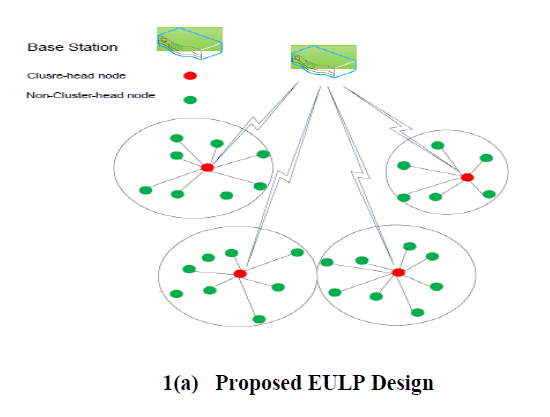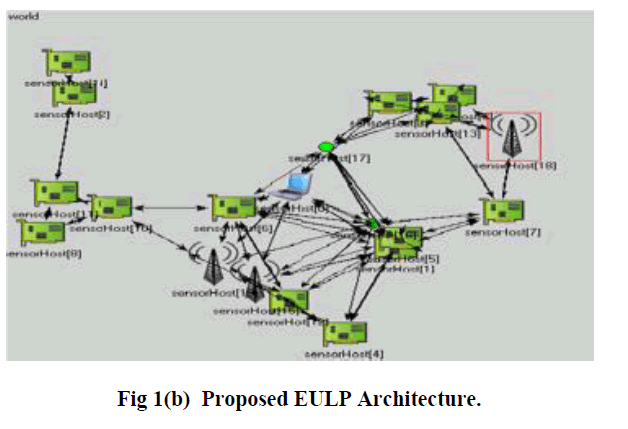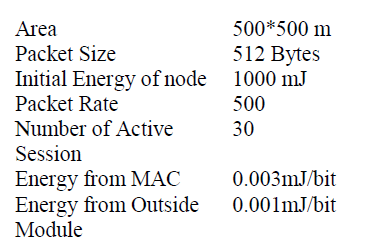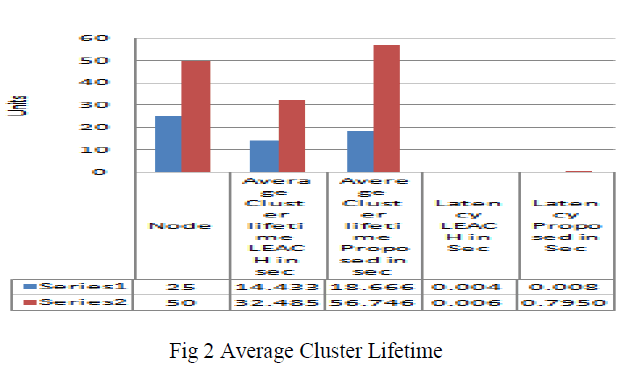INTRODUCTION |
| Recent advances in wireless communication technologies and the manufacture of inexpensive wireless devices have
led to the introduction of low-power wireless sensor networks. Due to their effortlessness of deployment and the multifunctionality
of the sensor nodes, wireless sensor networks have been utilized for a variety of applications such as
healthcare, target tracking, and environment monitoring. The main responsibility of the sensor nodes in each
application is to sense the target area and transmit their collected information to the sink node for further operations.
Resource limitations of the sensor nodes and unreliability of low-power wireless links, in combination with various
performance demands of different applications impose many challenges in designing efficient communication protocols
for wireless sensor networks. Meanwhile, designing suitable routing protocols to fulfil different performance demands
of various applications is considered as an important issue in wireless sensor networking. In this context, researchers
have proposed numerous routing protocols to improve performance demands of different applications through the
network layer of wireless sensor networks protocol stack.[8][3] Most of the existing routing protocols in wireless
sensor networks are designed based on the single-path routing strategy without considering the effects of various traffic
load intensities. In this approach, each source node selects a single path which can satisfy performance requirements of
the intended application for transmitting its traffic towards the sink node. Although route discovery through single-path
routing approach can be performed with minimum computational complexity and resource utilization, the limited
capacity of a single path highly reduces the achievable network throughput. Furthermore, the low flexibility of this
approach against node or link failures may significantly reduce the network performance in critical situations. For
instance, whenever the active path fails to transmit data packets such as a result of limited power supply of the sensor
nodes, high dynamics of wireless links and physical damages, finding an alternative path to continue data transmission
process may cause extra overhead and delay in data delivery. Therefore, due to the resource constraints of sensor nodes
and the unreliability of wireless links, single-path routing approaches cannot be considered effective techniques to meet
the performance demands of various applications. [5] In order to cope with the limitations of single-path routing
techniques, another type of routing strategy, which is called the multipath routing approach has become as a promising technique in wireless sensor and ad hoc networks. Dense deployment of the sensor nodes enables a multipath routing
approach to construct several paths from individual sensor nodes towards the destination. Discovered paths can be
utilized concurrently to provide adequate network resources in intensive traffic conditions. Alternatively, each source
node can use only one path for data transmission and switch to another path upon node or link failures. The latter one is
mainly used for fault-tolerance purposes, and this is known as alternative path routing. In the past decade, multipath
routing approach has been widely utilized for different network management purposes such as improving data
transmission reliability, providing fault-tolerant routing, congestion control and Quality of Service (QoS) support in
traditional wired and wireless networks. However, the unique features of wireless sensor networks (e.g., constrained
power supply, limited computational capability, and low-memory capacity) and the characteristics of short-range radio
communications (e.g., fading and interference) introduce new challenges that should be addressed in the design of
multipath routing protocols. Accordingly, existing multipath routing protocols proposed for traditional wireless
networks (such as ad hoc networks) cannot be used directly in low-power sensor networks. During the past years, many
issue has motivated the research community of wireless sensor networks to develop multipath routing protocols which
are suitable for sensor networks. |
BACK GROUND PAPER |
| There are several papers surveyed to develop a proposed routing protocol for wireless sensor networks. These
surveys describe and analyze the general routing strategies proposed for sensor networks. However, none of these
literatures has provided a comprehensive taxonomy on the existing multipath routing protocols for wireless sensor
networks. Following authors made us and gave idea and easy way to develop a proposed work. |
•L. Akyildiz, W. Su, Y. Sankarasubramanian and E. Cayirci, “A survey on sensor networks”, IEEE
Communications Magazine, vol. 40. no. 8, pp. 102-114, 2002. |
| Authors presented routing challenges and design issues in wireless sensor networks. They classified all the existing
routing strategies based on the network structure and protocol operation. Provided a brief overview on the existing
fault-tolerant routing protocols in wireless sensor networks and categorized these protocols into retransmission-based
and replication-based protocols. |
• G. N. Bravos and G. Efthymoglou, “MIMO-based and SISO multihop sensor network: Energy efficiency
evaluation”, Proceedings of IEEE International Conference on Wireless and Mobile Computing,
Networking and Communications, 2007 |
| G. N. Bravos and G. Efthymoglou, and et al. classified the existing multipath routing protocols in Wireless sensor
networks s based on the primary criterion used in their design. Accordingly, the principal motivation of conducting this
research was lack of a comprehensive survey on the proposed multipath routing protocols for wireless sensor networks.
To the best of our knowledge, this paper is the first effort to classify and investigate the operation as well as benefits
and drawbacks of the existing multipath routing protocols in sensor networks. |
PROPOSED WORK |
| The fundamental of the protocol is to develop a cluster based routing where cluster heads should be selected based
on maximum coverage and should have sufficient energy to prolong the communication. The following Figure 1(a) and
1(b) show the proposed work design and architecture of algorithm EULP(Extended and Updated Leach Protocol) ,
where we are routing through high energy node. And for cluster formation, selecting node with high node energy. |
 |
 |
ALGORITHM EULP |
Algorithm: EULP |
| [1]. Let W, H be the Network width and Height. Network Area A=WxH. |
| [2]. Let there be N nodes with Ei Energy at (Xi,Yi) point. |
| [3]. Let Node 0 be the Sink node located at W/2,H/2. |
| [4]. The problem can be summarized as to get a connected graph G={V,E} from S number of sources such that V are
the Nodes and E are set of all edges or Links, So as to maximize L where L is the Lifetime and is defined as time tl
when Ei<=0, where i can be any node other than the Sink. |
| [5]. Initially all node broadcast HELLO packets and let the other nodes know their Energy and Position. |
| [6]. Initially When Sink wants to gather data from Sources, It Selects the nodes with Maximum Neighbors and
Sufficient Energy as Cluster Heads. |
| [7]. Each Cluster head is notified that it is cluster head. |
| [8]. Source generates RREQ packet. |
| [9]. A node forwards RREQ packet only if it is a cluster head. |
| [10]. Route is formed between each source to sink through cluster heads. |
| [11]. Data is transmitted from source to Sink. |
| [12]. Nodes looses Energy as |
| [13]. Eloss= Eidle + Etransmit + Ereceive |
| [14]. and E=E-Eloss where Eidle=1pJ/s |
| [15]. Etranmit = 3mJ/Packet( considering packet is of |
| [16]. Length 1024) |
| [17]. Ereceive = 1mJ/Packet |
| [18]. During the Transmission if any Ei is less than 0, mark the time as Network Lifetime. |
| [19]. If a cluster head looses it's energy bellow 30% of the Max energy, then it notifies the source. An alternative
cluster head is selected, all the routes through previous cluster head generates RERR and new routes are formed. |
EVALUATION AND RESULTS |
| Following are the parameters used to evaluate the EULP |
| • Packet Delivery Ratio |
| Number of Packet delivered from source to sink/Number of Packets Generated at source Node. |
| • Latency |
| Average time of transmission of all packets from Source to Sink. |
| • Control Overhead |
| Number of Control packet sent( RREQ,RERR, HELLO,RREP)/Number of data packet Delivered. |
| • Average Energy Consumption |
| Avg (Emax-Ei ) where i=1,2..N and i!=Sink. The analysis of the proposed cluster based routing scheme where
cluster heads should be selected based on maximum coverage and should have sufficient energy to prolong the
communication. It is carried out using QualNet 7.0 to evaluate the energy consumption and maximize the lifetime of
the sensor network. A sensing field of dimension WxH (W =500 & H=500 m) with a population of N= 25 and 50
nodes is considered for simulation. The system parameters used for nodes 25, 50 for the simulation is listed below.
Average cluster lifetime and Latency Average cluster lifetime and Latency For 25 & 50 nodes. In the following fig 2
shows that Average Cluster Lifetime of Proposed EULP is better than Conventional LEACH. |
 |
 |
CONCLUSION |
| The conventional sensor network protocols like direct diffusion and Leach fails to ensure the credibility of the
network and fails to ensure longer lifetime. The lifetime maximization problem is generally seen as an isolated problem
in comparison to QOS problem. In EULP proposed research is QOS aware protocol which is provided that ensures
maximum lifetime of the edges through which routing is performed and thus minimizing the losses due to node
mobility or collision, thereby enhancing the lifetime by minimizing the Energy losses. Result show that the lifetime of
the proposed system is better than the conventional Leach. There are several other factors like bandwidth, delay that
affects the performance of the network which is correlated. But resolving the sharp relationships among the parameters
are difficult. Hence the work can be further improved by incorporating fuzzy decisions along with hard decision
Maximization problem. |
References |
- K. Khamforoosh, and H. Khamforoush, “A new rounting Algorithm for Energy Reduction in Wireless Sensor Networks”, IEEE, 2009
- J.N Al-Karaki, and A.E. Kamal, “Routing techniques in wireless sensor networks: a survey”, IEEE Wireless Communications, Vol. 11, No. 6 pp.6-28, December 2004.
- M. Younis, M. Youssef and K. Arisha, “Energy-Aware Routing in Cluster-Based Sensor Networks”,in the Proceedings of the 10th IEEE/ACM(MASCOTS2002), Fort Worth, TX, October 2002
- S. Lindsay and C. Raghavendra, “PEGASIS: Power-Efficient Gathering in Sensor Information Systems”, international Conf. on Communications,2001.
- J.N Al-karaki et al.,”DataAgggregation in Wireless Sensor Networks – Exact and Approximate2004.
- J. N. Al-Karaki, and G. A. Al-Mashaqbeh, “MATLAB: A New Simulation Platform for Wireless Sensor Networks”, International Conference on Sensor Technologies and Applications, 2007.
- http://alkautsarpens.wordpress.com/wsn/ Algorithms,” Proc. IEEE Wks. High Perf. Switching and Routing 2004, Phoenix, AZ, Apr. 18-21,
- R. V. Biradar, V. C. Patil, Dr. S. Sawant, and Dr. R. R. Mudholkar, “Classification and comparison of routing protocols in wireless sensor networks”, UbiCC Journal, Vol. 4.
- Shio Kumar Singh 1, M P Singh 2, and D K Singh,” routing protocols in wireless sensor networks –a survey”, International Journal of Computer
|